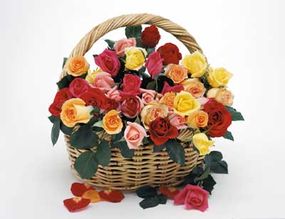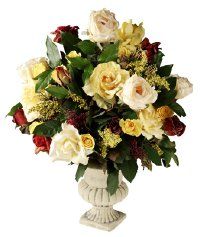Flower Arrangement Materials
To some people, making a flower arrangement without floral foam and waterproof, stretchable floral tape is like trying to cook a gourmet meal over a campfire rather than a modern range.
Still, for those emergencies when floral foam and floral tape are not on hand, other materials can do the job. There may even be times when some of these other materials are more desirable than floral foam and floral tape.
Advertisement
Chicken wire, pinholders, frogs, and Japanese fork sticks were used in flower arranging long before floral foam was invented. These still are handy to have around for use with or without floral foam. Chicken wire is especially helpful when used over floral foam to give extra support to heavy flowers like birds of paradise.
Twigs and clippings from evergreen shrubbery also were commonly used in the past. The problem, though, with such organic materials is that they decompose, spoiling the water, which then clogs up the conducting tubes of fresh plant material. Furthermore, certain evergreens -- arbor vitae is one of them -- give off ethylene, which hastens the aging and decay of fresh flowers.
Should you find yourself the happy, but surprised, recipient of a bouquet of flowers and have no floral foam with which to make an arrangement, look around the house for possible substitutions.
Plastic containers, cut-off milk cartons, Styrofoam cups, or plastic egg cartons can be poked with holes and turned upside down in a container. Plastic berry baskets turned upside down also might do the trick. A potato poked with holes will support plant stems and also ballast the container. Marbles, gravel, or sand might work, although dust from the latter two might clog the stems.
In a pinch almost any kind of tape you have around the house will hold floral foam or other anchoring material in place. Narrow strips of electrical tape, masking tape, adhesive tape, freezer tape, or any waterproof vinyl tape will do. Cellophane tape is not a good choice. It is brittle and is easily loosened by moisture. Try wire or string instead.
Foil and Floral Foam
With a little imagination, flowers can be used almost anywhere. An easy way to use flowers or foliage in unexpected, unconventional places is to use foil and floral foam. Foil-covered floral foam is ideal when you don't want water to spill or leak.

Arrangements in odd-shaped containers, such as an old shoe or a straw hat, or even arrangements in a non-container, such a combination of flowers and foliage with a pile of fruit on a tray, are easy with foil-covered floral foam.
A wicker basket filled with cuttings and a few flowers travels easily and can be attractive anywhere. Floral foam can be cut to fit any container. Then, the floral foam can be covered with foil to keep the water where you want it -- with the flowers. If you pull the sides of the foil away from the floral foam in a couple of spots, it will be easier to add water.
If flowers are short-stemmed, you can add height to your arrangement by inserting the short flowers into hollow stems such as those of a gladiolus or day lily, which are then inserted into the floral foam. By arranging the other flowers and foliage carefully, the joint won't show.
Fun flower arrangements, without fretting, are possible when using foil and floral foam.
Cuttings That "Bloom"
Fresh flowers also are a delightful way to perk up cuttings from your plants, making them pleasing decorative accents while they are rooting.
Short-stemmed flowers from your garden or a retailer, or leftover flowers from a bouquet can simply be placed with cuttings in a glass of water or a bud vase.
Floral foam also is excellent for this purpose. It works especially well with ivy, pachysandra, and sedums, as well as common indoor plant material such as coleus, Swedish ivy, and Wandering Jew.
When using floral foam for bouquets of cuttings and flowers, the same preservative that helps keep the flowers fresh also provides some protection against bacteria for the cuttings.
Once they have rooted, cuttings can be gently pulled from the foam or the foam can be broken apart to free the roots. If the roots have grown deeply into the foam, break away as much as possible and then pot up the remaining foam with the cutting.
Ready to try a new flower arranging technique? In the next section, learn about using a water pick to arrange flowers.
